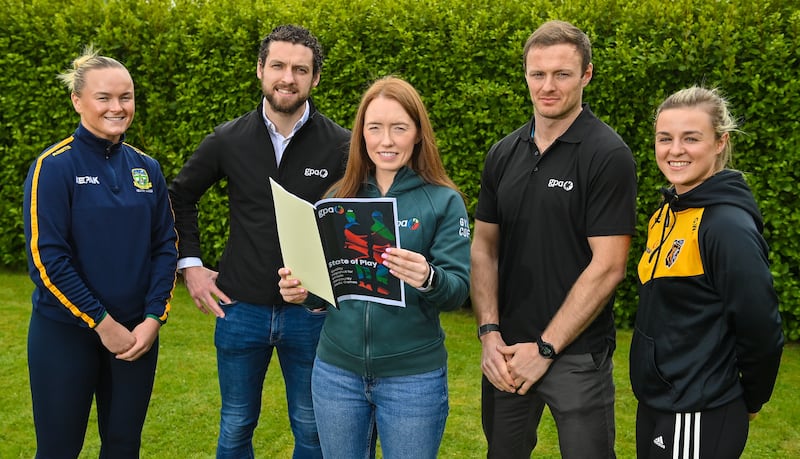Grace Walsh is talking buses and taxis and working split shifts in a bar. But what she’s actually talking about is playing for Kilkenny. And how any similarities between intercounty camogie and hurling tend to end as soon as you step off the pitch. She’s talking about equality.
The GPA launched its “State of Play” equality report on Tuesday – a survey of 1,579 women intercounty players – and are calling on the GAA, LGFA and Camogie associations to work together to bridge the gap in experiences and supports for women in Gaelic games.
The standout results from the survey are:
Only 9.5 per cent of women players receive travel expenses from their county board, with six per cent of those getting less than 20 cent per mile. Male intercounty players receive 70 cent per mile.
READ MORE
Some 79 per cent of players do not have regular access to a team doctor and 36 per cent do not have full access to a physio. Almost 50 per cent of female intercounty players have paid to visit a physio.
Just over half (53 per cent) don’t have full access to a gym while 71 per cent of respondents said they don’t have full access to suitable pitches. Some 72 per cent of players reported a perceived impact of the menstrual cycle on their performance and as such felt female-specific supports should be available.

But if they read only as cold figures, Walsh has lived them. She’s a nurse now and the 29-year-old is one of the best-known camogie players in the country, but her journey wasn’t straightforward.
Few players are as well positioned to compare how male and female intercounty players are treated – her brother Padraig is a Kilkenny hurler and another sibling, Tommy, was a key player during the Brian Cody era.
“Twice a week, midweek, I would have to get a bus to the city centre, get a bus from there to Kilkenny and then arrange for someone to collect me from the bus stop in Kilkenny and bring me to training,” she recalls of her time as a student in UCD.
“And then do the same on the way back. But by the time you’d get to Dublin it would be late and the bus out to UCD would no longer be running. I’d have to then pay for a taxi to get home that night, it would probably be 11-11.30. I had to try to fund that myself.
“I had a part-time job where I worked in a bar/restaurant. You’d work on a Friday night until all hours after training, then you’d get up on Saturday morning and do a split shift, I’d go home for a couple of hours during the day, and back in then to finish the night.
“By the time the clean-up is done, it’s half four or five o’clock when you’re actually leaving to get home. Then you’re trying to get some sleep and you’re getting up the following morning to go training. And probably also going back to work after that. That’s purely just to fund playing intercounty.”
Walsh was only too aware that her male counterparts at the time were experiencing intercounty life very differently. They would get picked up, brought to training, and dropped home again. And in many counties such disparity remains.
“That is one of the most frustrating things of all time, that you have to do that. You’re actually putting in more commitment and more effort and you’re treated less than your male counterparts.”

Medical treatment is also a challenging area for women players.
“If you need surgery you have to pay that money yourself and then claim it back from the insurance,” says Walsh.
“Whereas if a male intercounty player has to go for an operation, that thought probably doesn’t even cross their mind, because it’s covered for them and it’s sorted.
“It’s so frustrating because not one single person in this room would be here if it wasn’t for females and at the same time we’re still being treated second best when it comes to males and females.”
Meath footballer Vikki Wall says having a doctor at their matches is something of a recent development.
“Only in the last year or two we’ve had a team doctor and it’s not at every single training or every single game,” explains Wall.
“If you look across the board at women’s football and camogie, it’s definitely not the case [that teams have doctors]. It’s a luxury to have a doctor at any of our trainings or games.”

But while there is broad agreement on equality, the bottom line on such matters tends to be cash. Or, more to the point, who is going to stump up the money?
As moves towards integration between the GAA, LGFA and Camogie Associations continue, albeit slowly, the best placed of the trio to generate the resources is the GAA.
“If you look at what the intercounty game on the men’s side generates, when you consolidate it, it’s in excess of €150 million a year,” says Tom Parsons, chief executive of the GPA.
“Expenses for players are 4 or 5 per cent of that because it’s an amateur game. You look at other professional sports, 50 per cent of revenue goes on salaries. We don’t have that cost.
“Other sporting organisations are looking at this and scratching their heads and saying, ‘Well, 50 per cent of revenue goes on male salaries, how do we achieve equality?’ They can’t do it. In Gaelic games we absolutely can if there is a want and a will from the leadership. The resources are absolutely there, that’s my firm belief.
“We are not coming to the table and saying we want it equalised tomorrow, but we need a pathway towards closing the gap.”















